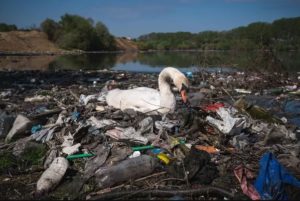Scientists have discovered more than 40 species of animals living in the Great Pacific Garbage Patch. The Great Pacific Garbage Patch is a collection of man-made debris in the North Pacific Ocean. In size it is more than 900 thousand square meters. km.
Like other polluted places in the world’s oceans, the Great Pacific Garbage Patch was formed by ocean currents, gradually concentrating trash thrown into the ocean in one area. Oceanologist Charles Moore estimates that 80% of this waste enters the water from land-based sources, and 20% is discharged from the decks of ships at sea. Moore says waste from the west coast of North America travels to the center of the vortex in about five years, and from the east coast of Asia in a year or less. Plastic pollution ends up in the world’s oceans through 10 rivers: the Asian Yangtze, Indus, Yellow River, Amur, Mekong, Ganges, Pearl and Haihe and the African Niger and Nile.
New research suggests marine animals are living in debris from the Great Pacific Spot. Scientists have discovered more than 40 coastal species such as mussels, amphipods, crabs, starfish and sponges. The spot became home to many marine animals. Notably, some of these species typically live only in coastal waters, and their presence in the open ocean is highly unusual. The emergence of a huge “garbage continent” in the area between the coast of California and Hawaii has led to the fact that many marine organisms found themselves at great distances from their usual habitat.
After studying them, it turned out that animals live on 90% of the floating garbage: sea anemones, tiny sea insects, mollusks and crabs were found in fragments of waste. “Plastic persists in the open ocean longer than the naturally occurring debris we have seen before,” explains study author Dr. Lynsey Haram of the Smithsonian Environmental Research Center. “Therefore, its accumulations create a more permanent habitat in the sea.”
There are at least five “garbage patches” in the world’s oceans in which gigantic amounts of plastic have accumulated. The Great Pacific Garbage Patch, which was the subject of this study, contains the most plastic: about 79 thousand tons over an area of 1.6 million square meters. km. “There’s a lot going on in these clusters,” says Dr. Haram. “We can’t say that the stain consists entirely of plastic, but it certainly accumulates a lot of it.”
Given the lack of natural shelters, alternative shelters made from garbage may become popular. However, interaction with waste threatens the life and safety of animals. Discarded batteries and plastic items can contaminate them with heavy metals and chemicals, while broken glass, can rims and fishing gear can cause dangerous damage. All this in the long term leads to a reduction in the unique population.
Not only marine animals use garbage – birds and higher mammals also use waste for their own purposes, for example, storks build nests from garbage, but most often animals look for food waste in garbage.
Specialists from The Ocean Cleanup decided to analyze the waste collected in the Pacific Garbage Patch. They examined the collected garbage to determine the country of origin of the waste. This turned out to be very difficult, since about a third of the collected garbage could no longer be identified, but the remaining 2/3 of the garbage examined turned out to be items inherent in fishing – cans, buoys, fish boxes, eel traps and much more. Further it became known that half of the items were produced in the last century. Based on this, experts concluded that plastic in the Great Garbage Patch can persist and accumulate for decades.
As it turned out, the leaders in supplying waste to the largest marine landfill on the planet are Japan (34%), China (32%), the countries of the Korean Peninsula (10%) and the USA (7%). Computer models that take into account ocean and sea currents, prevailing winds, daytime topography and possible waste disposal sites confirmed the fact that the main source of waste is the fishing trawler fleet.





